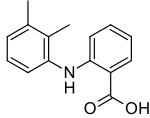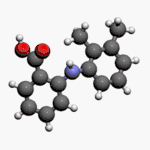Mefenamic acid
 | |
 | |
| Clinical data | |
|---|---|
| Trade names | Ponstel, Ponstan, others |
| AHFS/Drugs.com | Monograph |
| MedlinePlus | a681028 |
| Pregnancy category | |
| Routes of administration | by mouth |
| ATC code | |
| Legal status | |
| Legal status | |
| Pharmacokinetic data | |
| Bioavailability | 90% |
| Protein binding | 90% |
| Metabolism | Hepatic (CYP2C9) |
| Elimination half-life | 2 hours |
| Excretion | Urine (66%), faeces (20-25%) |
| Identifiers | |
| |
| CAS Number | |
| PubChem CID | |
| IUPHAR/BPS | |
| DrugBank | |
| ChemSpider | |
| UNII | |
| KEGG | |
| ChEBI | |
| ChEMBL | |
| ECHA InfoCard |
100.000.467 |
| Chemical and physical data | |
| Formula | C15H15NO2 |
| Molar mass | 241.285 g/mol |
| 3D model (JSmol) | |
| |
| |
| | |
Mefenamic acid is a member of the anthranilic acid derivatives (or fenamate) class of NSAID drugs, and is used to treat mild to moderate pain, including menstrual pain, and is sometimes used to prevent migraines associated with menstruation.[1][2] It is not widely used in the United States due to its side effects and high cost compared to other NSAID drugs.[3][4]:334
Its name derives from its systematic name, dimethylphenylaminobenzoic acid. It was discovered and brought to market by Parke-Davis in the 1960s. It became generic in the 1980s and is available worldwide under many brand names.[5] As of 2015 the cost for a typical course of medication in the United States is more than 200 USD.[6]
Medical use
Mefenamic acid is used to treat moderate pain and menstrual pain.[1]
There is evidence that supports the use of mefenamic acid for perimenstrual migraine headache prophylaxis, with treatment starting 2 days prior to the onset of flow or 1 day prior to the expected onset of the headache and continuing for the duration of menstruation.[2]
Side effects
Mefenamic acid is recommended to be taken with food.[7]
Known mild side effects of mefenamic acid include headaches, nervousness, and vomiting. Serious side effects may include diarrhea, hematemesis (vomiting blood), hematuria (blood in urine), blurred vision, skin rash, itching and swelling, sore throat and fever.[4]:334 It has been associated with acute liver damage.[3]
In 2008 the US label was updated with a warning concerning a risk of premature closure of the ductus arteriosus in pregnancy.[8]
Mechanism of action
Like other members of the anthranilic acid derivatives (or fenamate) class of NSAID drugs, it inhibits both isoforms of COX and prevents formation of prostaglandins.[3][9]
History
Scientists led by Claude Winder from Parke-Davis invented mefenamic acid in 1961, along with fellow members of the class of anthranilic acid derivatives, flufenamic acid in 1963 and meclofenamate sodium in 1964.[10]:718 U.S. Patent 3,138,636 on the drug was issued in 1964.[11][12]:918–919
It was approved in the UK in 1963 as "Ponstan", in West Germany in 1964 as "Ponalar", and in France as "Ponstyl" and the US in 1967 as "Ponstel".[3][12]:918–919
Society and culture
Availability and pricing
Mefenamic acid is generic and is available worldwide under many brand names.[5]
In the USA, wholesale price of a week's supply of generic mefenamic acid has been quoted as $426.90 in 2014. Brand-name Ponstel is $571.70.[13] In contrast, in the UK, a weeks supply is £1.66, or £8.17 for branded Ponstan.[14] In the Philippines, 10 tablets of 500 mg generic mefenamic acid cost PHP39.00 (or the equivalent of $0.88USD) as of October 25, 2014.
Synthesis
Analogous to fenamic acid, this compound may be made from 2-chlorobenzoic acid and 2,3-dimethylaniline.[15]
Research
While studies have been conducted to see if mefenamic acid can improve behavior in transgenic mouse models of Alzheimer's disease[16][17] there is no good evidence that mefenamic acid or other NSAIDs can treat or prevent Alzheimer's in humans; clinical trials of NSAIDs other than mefenamic acid for treatment of Alzheimer's have found more harm than benefit.[18][19][20]
See also
References
- 1 2 FDA Ponstel Label Updated February 19, 2008
- 1 2 Pringsheim T, Davenport WJ, Dodick D (April 2008). "Acute treatment and prevention of menstrually related migraine headache: evidence-based review". Neurology. 70 (17): 1555–63. doi:10.1212/01.wnl.0000310638.54698.36. PMID 18427072.
- 1 2 3 4 NIH LiverTox Database Mefenamic Acid Last updated June 23, 2015. Page accessed July 3, 2015
- 1 2 Jeffrey K. Aronson. Meyler's Side Effects of Analgesics and Anti-inflammatory Drugs. Elsevier, 2009 ISBN 9780080932941
- 1 2 Drugs.com drugs.com international listings for mefenamic acid Page accessed July 3, 2015
- ↑ Hamilton, Richart (2015). Tarascon Pocket Pharmacopoeia 2015 Deluxe Lab-Coat Edition. Jones & Bartlett Learning. p. X. ISBN 9781284057560.
- ↑ "Side effects for Mefenamic Acid". Medline Plus. National Institutes of Health.
- ↑ FDA March 2008 FDA advisory
- ↑ Prusakiewicz JJ, Duggan KC, Rouzer CA, Marnett LJ (August 2009). "Differential sensitivity and mechanism of inhibition of COX-2 oxygenation of arachidonic acid and 2-arachidonoylglycerol by ibuprofen and mefenamic acid". Biochemistry. 48 (31): 7353–5. doi:10.1021/bi900999z. PMID 19603831.
- ↑ Whitehouse M. Drugs to Treat Inflammation: A Historical Overview. pp 707-729 in Frontiers in Medicinal Chemistry, Volume 4. Eds Rahman A, et al. Bentham Science Publishers, 2009 ISBN 9781608052073
- ↑ US Patent 3,138,636
- 1 2 Marshall Sittig Pharmaceutical Manufacturing Encyclopedia Volume 1 A-K Archived 2007-10-23 at the Wayback Machine. Second Edition, Reprint Edition. Noyes Publications, 1988
- ↑ Drugs for Osteoarthritis. The Medical Letter, 56(1450):80-84, September 2014
- ↑ https://www.medicinescomplete.com/mc/bnf/current/PHP6487-mefenamic-acid-non-proprietary.htm accessed 19th sept 2014
- ↑ Trinus FP, Mokhort NA, Yagupol'skii LM, Fadeicheva AG, Danilenko VS, Ryabukha TK, Fialkov YA, Kirichek LM, Endel'man ÉS, Get'man GA (1977). "Mefenamic acid — A Nonsteroid Antiinflammatory Agent". Pharmaceutical Chemistry Journal. 11 (12): 1706–1711. doi:10.1007/BF00778304.
- ↑ Joo Y, Kim HS, Woo RS, Park CH, Shin KY, Lee JP, Chang KA, Kim S, Suh YH (January 2006). "Mefenamic acid shows neuroprotective effects and improves cognitive impairment in in vitro and in vivo Alzheimer's disease models". Molecular Pharmacology. 69 (1): 76–84. doi:10.1124/mol.105.015206. PMID 16223958.
- ↑ Daniels MJ, Rivers-Auty J, Schilling T, Spencer NG, Watremez W, Fasolino V, et al. (August 2016). "Fenamate NSAIDs inhibit the NLRP3 inflammasome and protect against Alzheimer's disease in rodent models". Nature Communications. 7: 12504. doi:10.1038/ncomms12504. PMID 27509875.
- ↑ Miguel-Álvarez M, Santos-Lozano A, Sanchis-Gomar F, Fiuza-Luces C, Pareja-Galeano H, Garatachea N, Lucia A (February 2015). "Non-steroidal anti-inflammatory drugs as a treatment for Alzheimer's disease: a systematic review and meta-analysis of treatment effect". Drugs & Aging. 32 (2): 139–47. doi:10.1007/s40266-015-0239-z. PMID 25644018.
- ↑ Jaturapatporn D, Isaac MG, McCleery J, Tabet N (February 2012). "Aspirin, steroidal and non-steroidal anti-inflammatory drugs for the treatment of Alzheimer's disease". The Cochrane Database of Systematic Reviews (2): CD006378. doi:10.1002/14651858.CD006378.pub2. PMID 22336816.
- ↑ Wang J, Tan L, Wang HF, Tan CC, Meng XF, Wang C, Tang SW, Yu JT. "Anti-inflammatory drugs and risk of Alzheimer's disease: an updated systematic review and meta-analysis". Journal of Alzheimer's Disease. 44 (2): 385–96. doi:10.3233/JAD-141506. PMID 25227314.
Sources
- MedlinePlus Drug Information: Mefenamic Acid. Last accessed September 28, 2005.
- Ponstel Pharmacology, Pharmacokinetics, Studies, Metabolism - Mefenamic Acid - RxList Monographs. Last accessed September 28, 2005.
- Consumption of NSAIDs and the Development of Congestive Heart Failure in Elderly Patients
- NSAIDs May Increase Risk for Worsening Heart Failure